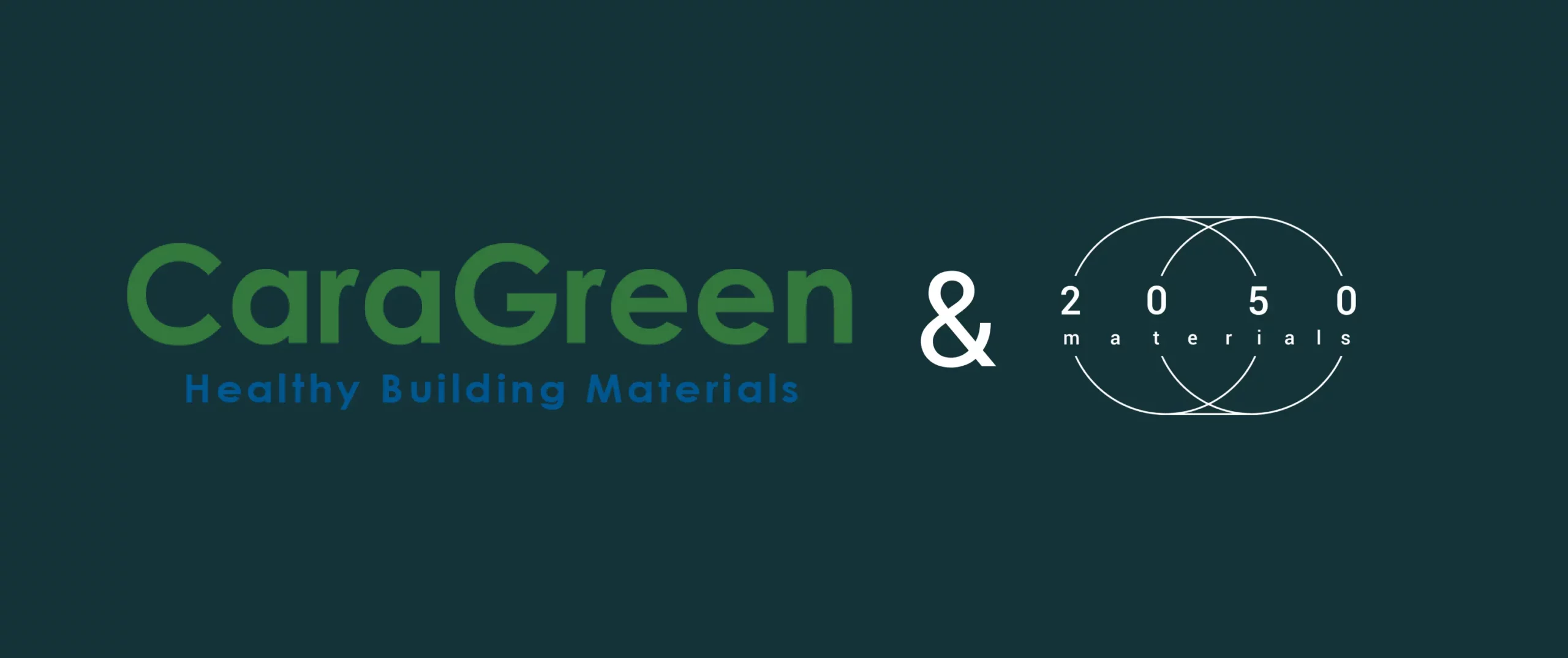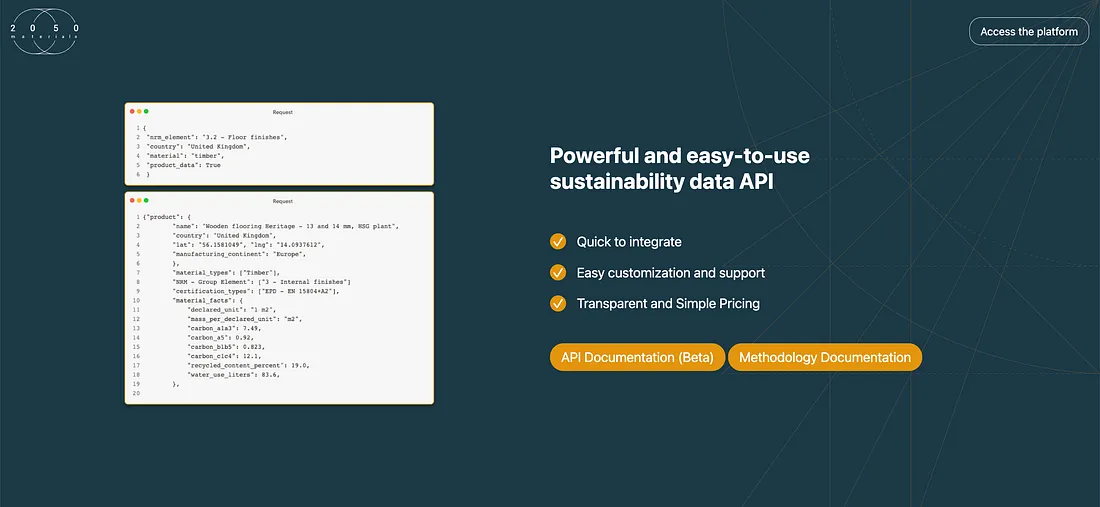Quantifying Sustainability: CaraGreen Discloses Building Material Data & Promotes Transparency Using 2050 Materials

CaraGreen was founded with a mission to provide a path to market for small and medium brands with sustainable attributes. A building material with sustainable properties is one that offers a reduced impact when compared to a traditional building material. These impacts can be measured as consequences to the planet overall, or as health effects to an individual. Each of the brands has their own unique sustainability story.
 And that story is not told by the number of trees we've hugged, it's told with data. 2050 Materials helps tell that story.
And that story is not told by the number of trees we've hugged, it's told with data. 2050 Materials helps tell that story.
2050 Materials is an online database where building industry professionals can find out both the ingredients and the effects of all types of building materials. The database houses information on materials’ circularity, water usage, carbon footprint, resilience, and health and inclusivity factors.
The EU, where 2050 Materials is based, along with the US, UK, and multiple other countries have committed through various agreements to have carbon neutral economies by the year 2050.
Why Sustainable Materials Matter
Why do we care? Committing to a carbon neutral economy by 2050 would keep the global temperature from rising more than 2ºC, which would avoid a whole host of negative global impacts like extreme weather events, ocean acidification, and social and economic disruptions.
Choosing building materials based on their sustainability performance not only avoids negative consequences, it produces positive change. Like diverting post-industrial recycled acrylic from the landfill by using a sheet of solid surface made with recycled content, rather than a traditional solid surface. Or creating spaces with cleaner air by using materials that are Red List Free, that is, free of certain chemicals known to be harmful to human health.
As more publicly and privately funded projects require building to elevated standards of efficiency and health, more product data will be required from manufacturers.
The Importance of Being Transparent
Material transparency describes the process of disclosing ingredients and processes required to make a product. Transparency empowers professionals to evaluate the environmental and health impacts of materials, leading to more sustainable choices and better outcomes for both projects and occupants.
Manufacturers can be hesitant to publicize their product ingredients for fear of competitors getting access to their trade secrets. Environmental Product Declarations (EPDs) and Declare labels (think ingredients list on the back of a cereal box) allow for manufacturers to list proprietary ingredients without disclosing the exact chemical makeup, allowing manufacturers to disclose at their comfort level. Ideally every single ingredient could be made public, but starting somewhere is better than never beginning the disclosure process at all.
But who is collecting the data and how does it plug into the host of transparency platforms and tools out there?
2050 Materials API Integration to Streamline Transparency of Data
2050 Materials platform and Application Programming Interface (API) play a crucial role in the construction and architecture industries by facilitating access to comprehensive building material data. The platform offers an extensive database that architects, engineers, and sustainability consultants can leverage to make informed decisions about the materials they use in their projects.
With a focus on environmental impact, 2050 Materials’ API provides a seamless, data-driven approach for analyzing key insights into the life-cycle assessments of various materials, helping professionals to choose options that are not only durable and cost-effective but also environmentally friendly. By integrating this data seamlessly into the workflows through the API, users can optimize the sustainability of their designs, meet regulatory requirements, and contribute to the global effort towards reducing the construction sector’s carbon footprint. This tool is invaluable in an era where sustainable building practices are not just a preference but a necessity.

2050 Materials API
Here are some case studies on 2050 Materials successfully integrating the API into other tools, if you are interested in knowing more.
CaraGreen's Efforts in Sustainability and Transparency
CaraGreen represents and distributes a suite of sustainable interior and exterior finishes. The products include sintered stone, recycled glass surfacing, phenolic surfacing made with recycled paper, and wall covering made with real organic materials like alpine hay and wildflowers, to name a few. Some materials are made with recycled paper, or recycled glass. Other materials can be recycled at end-of-life and made into new products. Each product has its own unique sustainability story.
 We work with our manufacturers to build important transparency documentation such as Health Product Declarations (HPDs), EPDs, and Declare labels. We also make sure we list our brands on 2050 Materials.
- Raina, Territory Manager from CaraGreen
We work with our manufacturers to build important transparency documentation such as Health Product Declarations (HPDs), EPDs, and Declare labels. We also make sure we list our brands on 2050 Materials.
- Raina, Territory Manager from CaraGreen
Rather than going on a scavenger hunt through each manufacturer’s website to find sustainability data, 2050 Materials has built one centralized location where sustainability data can be found. Once data is all out on the table, building professionals can do an apples to apples comparison. The easier this product data can be found, the more likely it is these products with sustainability performance will be specified and make it into buildings.
Looking Ahead: Transparency to Optimization
CaraGreen is dedicated to offering a diverse range of materials based on their sustainability performance and environmental responsibility. Through rigorous certification processes and comprehensive product information, CaraGreen ensures transparency and empowers customers to make informed decisions that align with their sustainability goals.
There’s no perfect product (or if there is, let us know!), but transparency is the baseline needed to begin the process of product optimization.
Step one: disclose ingredients and processes.
Step two: optimize.
By choosing materials with lower carbon footprints and fewer harmful chemicals, architects and designers can play a significant role in mitigating climate change and safeguarding human health.
As the demand for transparency continues to grow, CaraGreen is taking proactive steps to optimize material health and performance. Collaborations with initiatives like 2050 Materials underscore CaraGreen’s commitment to driving innovation and setting new standards for sustainability in the built environment.
Related articles

Building a Legacy with Hutton Stone
Hutton Stone, a heritage-driven quarrying company led by Marcus Paine, exemplifies how traditional materials can meet modern sustainability demands. From the careful stewardship of quarries to low-carbon innovations like split and sawn stone bricks, Hutton Stone merges architectural legacy with environmental responsibility. As part of the SME Climate Hub and the UK Ethical Stone Register, their operations demonstrate that ecological care and construction excellence are not mutually exclusive—but mutually reinforcing.
Read more
Case Study: Citu Climate Innovation District
As the desire to build lower carbon housing grows, Citu’s Climate Innovation District in Leeds stands as a blueprint for environmentally conscious development.
Read more
Harnessing Solar Power and Energy Efficiency: SolarLab’s Innovative Facade Solutions
SolarLab is harnessing solar power and energy efficiency providing an innovative solution that not only pays for itself but also generates energy.
Read more